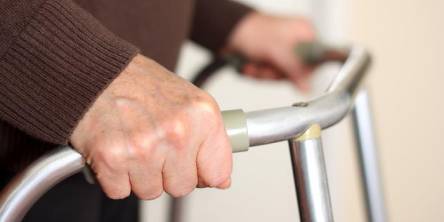Why Senior Care Industry Is Expected to Grow
When you take a look around, you realize that the country is aging and getting a few more gray hairs. More baby boomers are entering early retirement and modern medicine is helping us to live longer into our golden years.
Recent U.S. Census data also shows that the baby boomers are driving up the average age in America. Research out of the Pew Research Center also says that one-in-seven adults over the age of 65, or senior citizens, can't drive a car. An even higher percentage have mobility issues.
A full 13 percent, or 39 million Americans, are senior citizens. As it turns out, people are also living longer, so you can expect the number of senior citizens to really balloon in the next 30 years.
In fact, by 2050, Pew Research also found that one-in-five Americans will be at least 65 years old and the number of people at least 85 years old will more than double compared to today's number of octogenarians.
That will inevitably mean changes to things like social security and medicare, but it also means more seniors with mobility issues will join the elder care industry.
The Elder Care Industry Is Expected to Surge
Care for seniors with mobility issues is expected to surge over the next two decades because America's baby boomers are aging, we're living longer as a nation, and more senior citizens need help with things like getting groceries and getting from one place to another.
The changes could actually come sooner than many anticipate. Forbes magazine wrote a whole article about how an aging America will create a multi-billion dollar elder care industry in 2020. Specifically, Forbes took note of the 117 million senior citizens who by 2020 are going to need some kind of homecare assistance.
A $279-Billion Industry Awaits
An aging America could create a $279-billion homecare industry by 2020 since more seniors are going to need assistance on a daily basis.
The elder care industry going to skyrocket over the next few years since the number of unpaid caregivers will only be 45 million, which covers less than half of the 117 million senior citizens who will need some kind of assistance in three years' time.
The AARP—American Association of Retired Persons—supported these findings and found that the elder care industry will grow by more than 10% over the next three years.
The caregiving tech industry that covers things like monitoring devices for seniors is also filling a void in the industry since two-thirds of family caregivers like the idea of using technology to track the health and safety of loved ones, yet only 10% are currently able to do so.
Closing that gap is going to drive a lot of the growth in the caregiving industry through 2020.
Business Opportunity Broken Down
AARP's Caregiving Innovation Frontiers report lays out the business opportunities that lie ahead.
Opportunities in the caregiving industry are broken down into six general areas: daily activities, health and safety awareness, care coordination, transition support, social well-being, and caregiver quality of life.
Daily Activities
The first opportunity, daily activities, is what most of us think of when we think of caregiving opportunities.
Daily activities include meals, home personal care, and things like grocery deliveries in addition to less common chores like home repair.
Because this is such a general category, you can expect it to present a significant business opportunity. And it does.
The daily activities part of caregiving accounts for $207 billion of the $279-billion industry that will be the caregiving industry by 2020. That's absolutely huge.
Health and Safety Awareness
Health and safety awareness will still be important since it covers critical senior issues like medication management and safety monitoring. Caregiving tech could play a big role here.
Tech could also play a large role in care coordination since caregivers will need to use technology to better manage care planning and recovery support.
Social Well-Being
The basic idea behind all of these caregiving subindustries is linking up a solution to a need. As it turns out, one of the things that senior citizens also need is more time around other seniors.
Seniors report being lonely at higher rates, so when caregivers can provide well-being opportunities for seniors to stay connected, that's a huge plus.
Transition Support
Home retrofitting and long-term care insurance planning are critical services that seniors need during transitional periods.
That's why transition support is poised to become a $20-billion-plus industry within a much larger caregiving industry by 2020.
Similar Articles
For individuals requiring extensive support and assistance with daily activities, in-home care is an invaluable resource. This level of care provides continuous support and supervision, ensuring that individuals receive around-the-clock aid in the comfort and familiarity of their own homes.
When choosing an assisted living community, it is essential to consider the type and quality of food offered. This is generally one of the first things people look at when they tour different communities because it can affect the quality of life for residents immensely.
Summers mean several things for several people - numerous enjoyable outdoor activities such as picnics, swimming, barbecuing, and going to the beach, among others. However, the rising temperatures can pose major health risks, particularly for the elderly.
Old age comes with its own set of problems and one of the most serious issues the elderly have to face is heart problems. While heart issues can affect anyone, the risk of cardiovascular disease goes up as you get older. In fact, more than 67% of people between the ages of 60-79 years suffer from some form of heart disease.
Dementia is a frightening condition with the primary symptom being declining memory loss and the overall inability to perform simple problem-solving tasks. Additionally, it impacts a person’s ability to think critically, whilst affecting the language patterns. It is a common occurrence among the elderly in society.
This article will show you the six important steps you should follow when hiring an in-home care agency. Learn here more about how to find the right in-home care agency near your area.
Sheltered accommodation is another in the list of long-term elderly care options as opposed to care homes, care in the community or living with family. Often it is called warden-controlled accommodation, as this is one of the benefits, there is a warden on site usually 24 hours, they often live on site.
A fundamental part of giving care is being a good communicator with the person getting care. Care is given with respect for the dignity of the person receiving care. The carer remains in contact with the primary health care provider, often a doctor or nurse, and helps the person receiving care make decisions about their health and matters affecting their daily life.
Mobility aids are the best medical products used by the disabled and elderly to walk easily, which are not capable to move or walk freely on their own. Today, the market is flooded with many kinds of mobility aids.









